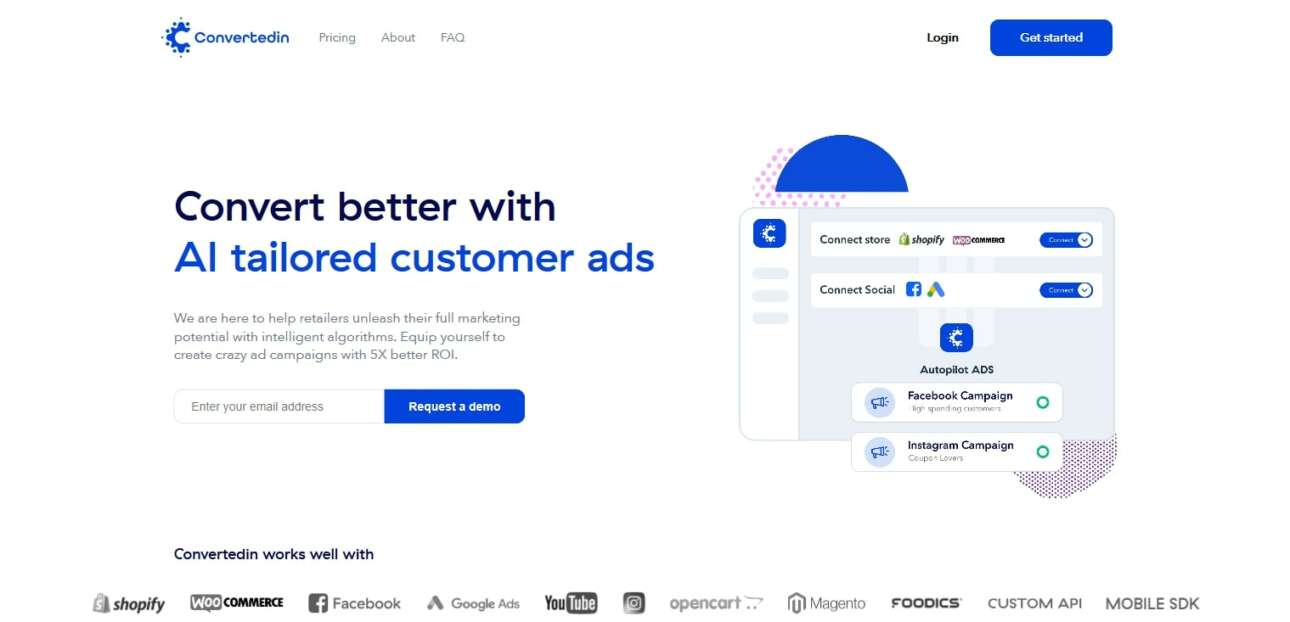Top 8 Cross-Selling Strategies To Increase Your Revenue (With Examples)
Did you know that, according to recent studies, cross-selling can increase sales by 20% and profits by 30%?
Need to familiarize yourself with cross-selling? Then, allow us to walk you through it.
We will ask you a question, and we want you to answer as a customer and not as an eCommerce marketer or an owner of an eCommerce store.
Have you ever added a shirt to your cart while shopping online, and then when you were checking out, the store recommended a pair of pants that would go perfectly with that shirt, and you simply just couldn’t resist buying the entire outfit?
If this ever happened to you, you should know this is called “Cross-Selling.”
Cross-selling is one of the strategic weapons that eCommerce marketers resort to whenever they want to stay ahead of the competition without exerting much effort. It is a simple but highly effective sales and marketing strategy that involves suggesting products related to or complementary to other products that customers have already purchased or are interested in.
Some people define the cross-selling strategy as a type of product recommendation that capitalizes on customers’ desire to buy additional products that complement their original purchase or that align with their interests.
In this article, we will tell you the secret to successfully implementing cross-selling by providing you with the best cross-selling strategies you can use to increase the revenues of your eCommerce store with little effort.
Table of Content:
- Recommending Related Products
- Recommending Complementary Products
- Providing Complementary Services
- Showing Recently Viewed Products
- Leveraging Social Proof
- Cross-Selling At More Than One Place
- Persuading Customers With Product Bundles
- Combine Personalization With Cross-Selling
Top 8 Cross-Selling Strategies For E-Commerce Stores (With Examples)
As we said, cross-selling is a powerful strategy eCommerce businesses use to increase profits and improve the overall customer shopping experience. Cross-selling is very commonly used; however, not everyone knows how to make the most of what this strategy can offer. The secret to successfully implementing a cross-selling strategy in your eCommerce store is in the following points.
1- Recommending Related Products
When talking about cross-selling strategies, recommending related products might seem to you like a very basic strategy. However, basic does not mean obsolete or useless. From our perspective, a basic strategy is essential for you to understand all other strategies.
Cross-selling with related products simply means recommending products that are similar to what the customer has purchased recently, is currently purchasing, or has expressed interest in. Using related product recommendations as a way of cross-selling is usually very convenient for customers because it helps them find relevant options, which saves them a lot of time and effort.
This cross-selling strategy comes in different forms. You can find eCommerce websites using it through phrases like “If you liked this, then you might also like this,” “You might also love…,” or as in the case of our example here: “Pieces we think you’ll also like.”
Example: Abercrombie & Fitch
 Image source: segment.com
Image source: segment.com
Abercrombie & Fitch is an American lifestyle retailer that specializes in casual wear. It is one of the eCommerce stores that are successfully using this cross-selling strategy. As we can see in the previous image, when a customer expressed interest in a certain type of jeans, the website used cross-selling by recommending other jeans that are very related to the taste and style of that customer.
2- Recommending Complementary Products
Yes, this strategy is different than the previous one because recommending complementary products is not the same as recommending relevant products. Always keep in mind that, relevant products do not have to be complementary; however, complementary have to be relevant.
Complementary products are items that will complement what your customer is buying and be used in conjunction with it.
This cross-selling strategy comes in different forms. You can find eCommerce websites using it through phrases like “Shop the look,” “Frequently bought together.,” or as in the case of the two following examples: “Wear with one of these,” or “Grows well with.”
Example (1): Bonobos
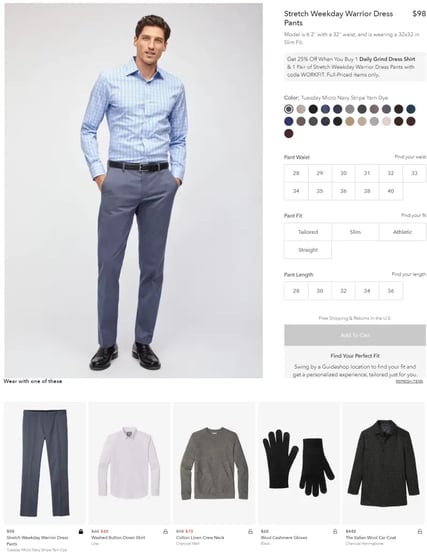 Image source: sellbrite.com
Image source: sellbrite.com
Bonobos is an e-commerce brand that designs and sells menswear including men's suits, trousers, denim, shirts, shorts, swimwear, outerwear, and accessories. As we can see, Bonobos implemented cross-selling by recommending complementary products. The eCommerce brand used the phrase “Wear with one of these…” to recommend products that would complete the customer’s outfit when they buy the pants that they’re interested in.
In the previous example, the “complementary product” strategy for cross-selling is successful. However, this strategy is even more successful when the complementary item is not just appealing but indispensable for the use of the product you’re buying. Take a look at the following example.
Example (2): The Sill

The Sill is a brand that sells plants. On its eCommerce store, you can find different types of plants and other related products. When you visit the brand’s eCommerce website, you will easily notice it implementing cross-selling by recommending complementary products.
Notice here that the brand made a very smart move by choosing a cross-selling strategy that is suitable for it. To better illustrate, the brand knows that buying a plant is not enough and that customers will need to buy complementary products to take care of that plant. As we can see in the previous image, the brand knows that the customer who’s buying the “Heart Leaf Hoya Variegated” plant will not be able to take care of it without the “Organic Potting Mix,” and the “Soil Moisture Metre.”
3- Providing Complementary Services
If you are implementing cross-selling by offering complementary products, you might as well offer complementary services. Just like products, services can be used within a cross-selling strategy. The complementary services that you can cross-sell with can include delivery, wrapping, product assembly, product repair, insurance, warranty, and others.
Example: Wayfair
.webp?width=602&height=301&name=wayfir%20(1).webp) Image source: detroitnews
Image source: detroitnews
Wayfair is an online retailer that sells furniture and other home-related products. It has been successfully implementing cross-selling within its eCommerce store by offering a complementary service called “Handy”.
This eCommerce brand capitalizes on the fact that it is selling products that might be difficult for customers to assemble on their own. It uses the phrase: “Leave assembly to the experts” to make customers feel that they need this service when they’re buying a piece of furniture from the eCommerce store.
4- Showing Recently Viewed Products
This cross-selling strategy works as a kind of “reminder” to the customers. It consists of reminding them of products that they have seen recently and expressed interest in but might have forgotten about.
You might ask yourself how is this different from the first strategy we discussed. The main difference is that here you do not have to recommend relevant products. You simply just have to recommend products that the customer has already laid eyes on before.
This specific strategy will not just help you increase sales but will also show your customers that you care about them by keeping track of their browsing history. It is a very useful strategy especially if your eCommerce website gets a lot of returning visitors.
Example (1): Amazon
 Image source: bensbargains
Image source: bensbargains
Example (2): eBay
 Image source: techwalla.com
Image source: techwalla.com
Amazon and eBay, which have two of the strongest eCommerce website in the market, use this cross-selling strategy. Both retailers present their customers with a section that shows all the products that they have viewed recently. This works as a reminder and motivates customers to revisit those products and buy them.
5- Leveraging Social Proof
You should already be aware of the significance of social proof when it comes to eCommerce marketing and sales strategies. Cross-selling is no exception to that. In other words, social proof is as essential for cross-selling as it is for anything else in eCommerce.
Social proof can be used with cross-selling in different ways:
- You can display customer testimonials and reviews with the products you are recommending.
- You can also utilize user-generated content by displaying images or videos, featuring customers wearing or using the primary product in addition to the product you are trying to cross-sell.
- You can employ social proof through influencer marketing by collaborating with influencers who can promote each main product alongside the item you wish to cross-sell. This will make your customers think “If influencers are buying these products together, then perhaps I should too.”
Example: Amazon
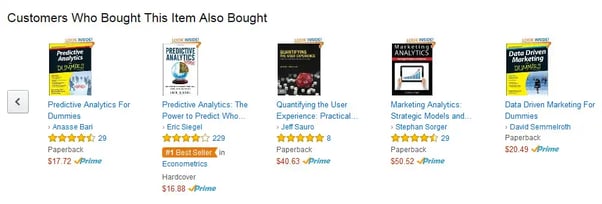
Yes, we are using Amazon as an example for the second time because it is successfully using more than one cross-selling strategy. You can do that too if it is suitable for the objectives of your eCommerce store.
6- Cross-Selling At More Than One Place
There are multiple places in which you can display cross-selling and we advise you to diversify between them instead of just depending on only one place.
- Cross-selling at checkout: When using cross-selling at checkout, make sure to consider a few things. First, consider the type of products you’re selling or the services you are offering. Second, in light of the first consideration, think about what exactly would your customers be interested in when checking out from your online store: A relevant product? A complementary product? An additional service? Or something else entirely?
Example: Under Armour
 Image source: OptiMonk
Image source: OptiMonk
- Cross-selling on product pages: Cross-selling on product pages is also a good option, especially when it comes to recommending relevant products.
Example: ASOS
 Image source: kimonix.com
Image source: kimonix.com
Notice that in the previous example, while implementing cross-selling on its product pages, Asos used more than one cross-selling strategy. To demonstrate, the brand used the phrase “You might also like” to recommend related and relevant products and used the phrase “Buy the look” to recommend a complementary product.
- Cross-selling through emails: Cross-selling using emails is not something new. It has been used for years by eCommerce businesses to get customers to come back and buy more products.
Example: Monsoon
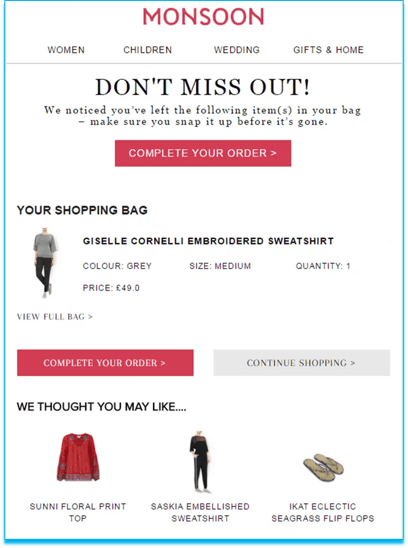
Notice that in the previous example, this was an abandoned cart email that included a cross-selling strategy within it. Monsoon used this email as an opportunity to cross-sell by recommending to its customer some products that she might like. Also, notice how the brand used FOMO marketing by using the phrase “Don’t Miss Out!”.
- Cross-selling via pop-ups on the website: Popups are great at catching the attention of customers, especially when it is used for cross-selling. Nevertheless, it is important to keep in mind that popups should be used thoughtfully and strategically so that they wouldn’t end up overwhelming or annoying the website visitors.
Example: Harry’s
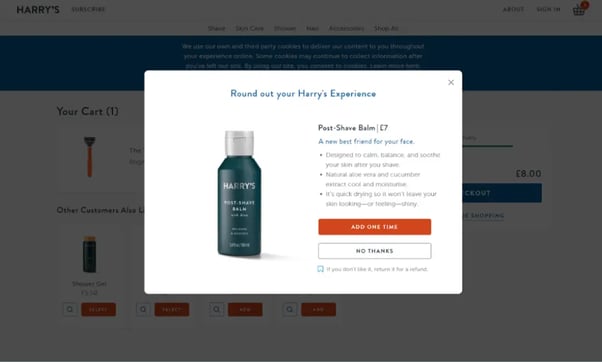
7- Persuading Customers With Product Bundles
Another effective strategy used in cross-selling is, as some people call it, “Product Bundling”, which refers to grouping a bunch of relevant or complementary products in a bundle and offering them to customers with a special discount.
Example: Glossier
.webp?width=602&height=281&name=cross-selling-strategies-Glossier%20(1).webp) Image source: yieldify.com
Image source: yieldify.com
As we can see in this example, Glossier is using cross-selling by recommending a bundle or a set that includes the product the customer is interested in with a bunch of other related products at a discounted price.
8- Combine Personalization With Cross-Selling
Besides social proof, personalization is another concept that you read about a lot when it comes to eCommerce. Personalization gives you a chance to tailor your cross-selling recommendations to your customers based on their different preferences, buying history, browsing behavior, and other aspects.
Example: Nike
 Image source: convertflow.com
Image source: convertflow.com
Nike is one of the brands that combine personalization with cross-selling on its eCommerce website. As we can see in the image, the recommended products are personalized based on the customer’s most recent purchase.
Final Thoughts:
To sum up, we now all agree that cross-selling is one of the most powerful strategies that an eCommerce business can use to enhance customer engagement, boost sales, and increase profits and revenues. Throughout this article, we tackled some of the most effective cross-selling strategies that you can implement in your eCommerce store.
One final thing that we are offering you today is the chance to use automation, which will simplify the implementation of the previously discussed cross-selling strategies. Converted.in is offering you a marketing automation tool that will:
- Store all your customer’s data in one place like a hub, which will facilitate the process of recommending personalized products for them.
- Create, launch, personalize, and automate email marketing campaigns within which you can implement cross-selling.
Book your demo now and start discovering the journey of cross-selling.
 By
By

